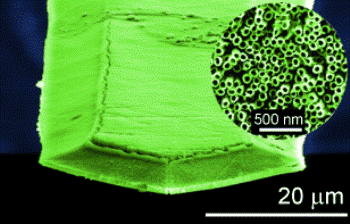Research teams headed by Valérie Keller from the Laboratoire des Matériaux, Surfaces et Procédés pour la Catalyse and Denis Spitzer from the French-German Research Institute of Saint Louis have designed a micromechanical sensor based on male silk moths’ ultrasensitive sense organs used to detect pheromone molecules released by females.
 © Wiley-VCH
© Wiley-VCH
This sense organ features large antennae covered with chemonsensing, neuron-containing porous hairs called sensilla. The researchers used microcantilevers for the fabrication of their novel sensor. To improve the sensitivity of microcantilevers for reliably detecting the trace amounts of explosives such as trinitrotoluene (TNT), the researchers equipped them similar to the butterfly antennae.
The scientists used a dense three-dimensionally ordered titanium dioxide nanotube layer to coat the microcantilevers. The nanotubes were vertically oriented just as the butterfly sensilla, thus yielding numerous benefits. This novel structure improves the bonding of titanium dioxide to materials containing nitro groups, which are basic to TNT and other explosives; substantially increases the microcantilevers’ specific surface; and enhances the mass movement due to the open structure of the tubes, thus ensuring a quick sensor response.
The nanotubes have nearly 100-nm diameter, 1,700-nm length and 20-nm wall thickness. Every microcantilever can hold up to 500,000 nanotubes. To test their micromechanical sensor, the scientists produced TNT vapor by heating a small crystal. The sensor detected concentrations of below 1 ppt in 3 minutes.
The research groups are now involved in the development of a selective detector system to sense explosives and other gases using this process. The study results have been reported in the Angewandte Chemie journal.
Source: www.angewandte.org